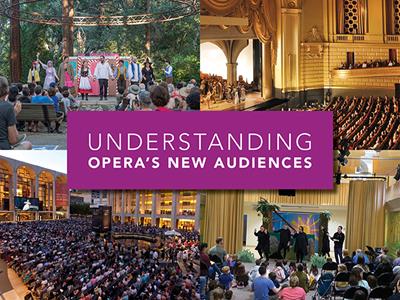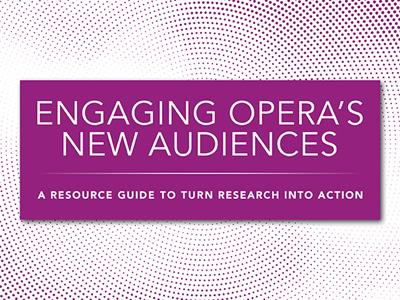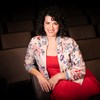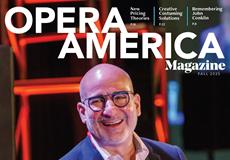Meet Them Where They Are: A Response to Understanding Opera’s New Audiences
The following essay is a response to OPERA America's Understanding Opera’s New Audiences report and how its findings can inform strategy across the field.
What gets a first-time operagoer in the door? The insights in OPERA America’s Understanding Opera’s New Audiences report might not always be what we want to hear, but they’re exactly what we need to know. This study explores motivators and barriers that affect new audiences’ relationships with opera. Among its key findings: Programming, pricing, and the overall experience play a huge role in how new-to-opera patrons relate to our offerings. These factors are central to whether a first-time attendee becomes a repeat patron — or simply never returns.
If you’re like me, your first response to the 70-page report may have been to sigh with fatigue and jump to the key findings, skimming the rest, before letting the file languish in your downloads folder. At first glance, the report affirms what most of us probably know: new audiences overall are slightly younger, more diverse, and have fewer higher degrees, and they spend more time interacting with contemporary cultural offerings than our ongoing patrons. A few findings raised my eyebrows, like “Many New-to-Opera attenders listen to and watch opera recordings before they attend in person,” which made me ponder how we can digitally engage with people before they attend a performance.
Given how essential OPERA America’s Annual Field Report has been for benchmarking in my company’s strategic planning process, I decided to take a second look at Understanding Opera’s New Audiences before shelving it — and discovered a wealth of data behind each key finding. Here is a treasure trove, if you have the patience of a beachcomber. My best advice: Try not to tackle it in one sitting. Rather, digest it in several courses, allowing each page to spark questions and invite further investigation. Curiosity is key here. I found myself coming back to it again and again over several weeks, each time walking away with new understanding, new questions, and new ideas.
One of the most significant findings is that new audiences prefer classic, well-known operas. Given that 54% of our industry’s offerings are inherited repertoire (Annual Field Report 2024), this should come as no surprise — new audiences are very likely to encounter these works. But it does raise important questions about how companies that champion new works can bridge that gap. Specifically, across all three audience types (New-to-Opera, New-to-Company, and Ongoing), the most motivating factor for attendance is “if it is a famous or well-known opera.” Lesser factors are “if the opera ... deals with relevant issues to today,” “if the opera is by a composer and/or librettist who is/was a woman, person of color, or LGBTQ+,” and, lastly, “if the opera is by a living composer and/or librettist.” Ouch.
First, for those companies whose programming includes classic works, let’s make this the launchpad, not the death knell, for innovation. Within the scope of your repertoire, are there opportunities to reimagine familiar works? Can we go beyond changing the setting of a story from one century to another and weave in contemporary cultural references? One example: Pacific Opera Project’s #Superflute transposes Mozart’s Die Zauberflöte into a 1990s video game universe, merging nostalgia with imagination while subverting the racist overtones of the original libretto (this production was featured in Northwestern University’s “Decolonizing Theater in the Long 18th Century” series). Our 2023 #Superflute revival crushed our previous box office records and welcomed a new crowd of non-regular opera attendees — over 50% of audience survey respondents did not “regularly attend opera productions by other companies,” as opposed to our more typical 30–35%. Some traditionalists might balk at this treatment of opera’s own Bard, while others would argue that Mozart himself would have enjoyed this production. Whatever your take, its appeal to new audiences was undeniable.
For companies whose programming prioritizes new works, this preference for inherited repertoire might be downright infuriating. If a company’s mission is rooted in giving voice to underrepresented composers and championing new works, what’s the appropriate response? This study highlights factors beyond programming that can attract opera newbies. If repertoire is inflexible, companies can leverage intersecting patron interests. Alternate companies performing in non-traditional venues have a unique opportunity to connect with audiences already engaged with those spaces, themes, or identities. Strong partnerships can amplify this reach. If New-to-Opera attenders are more likely to come for the “experience” than the music, companies programming new works are poised to offer an experience like no other.
A key finding addresses the problem of “experience” and reports that New-to-Opera audiences are “more likely ... to feel disoriented or distanced during the performance.” What causes that? This study reveals factors like language, length, or not understanding enough about opera have a distancing effect. If you’re not already following Kerriann Otaño, vice president of engagement at OperaDelaware, please do so right now. She is a true champion of what it means to create a welcoming, familiar space for new audiences. Her practice of “joyful advocacy” for opera is a beacon for artists and audiences alike.
While it’s good practice to educate our audiences about opera’s creative human industry in order to increase its perceived value, let’s be wary of telling new audiences how they should feel about opera, and explore further how to make opera experiences they want to attend. We know that New-to-Opera attenders are more likely to purchase discounted tickets — let’s be sure that buying tickets is easy and fun. Contingent discounts like rush tickets or resident-only offers may create unnecessary barriers. Each organization can examine its array of segmented discounts and tiered subscription models, targeted to entice our price-sensitive audiences.
I would encourage smaller companies that are tight on human resources and capital not to be put off by the largeness of the problem. Pick the study’s key finding with your easiest entry point. Is it programming? Explore how you can refresh one of the warhorses. Or, if your focus is new works, pilot a subscription partnership with your city’s modern art museum. Price? Test if you can increase your first-time patron return rate by sending them a “killer offer,” the sweet combo of famous repertoire, a wicked discount (up to 50% off, or bring a friend for free), and the best night (Saturday) to entice a return. Is it experience? Offer free drinks at the show, plan a pre-performance pub crawl, or encourage patrons to come in costume. Use newcomer-friendly language in your marketing — who outside of opera knows the word Sitzprobe?
Finally, I would urge us to view Understanding Opera’s New Audiences as an invitation, not a destination. We can’t be so focused on getting New-to-Opera attenders to show up that we forget to invite them back. The League of American Orchestras’ 2008 churn study tells us that 90% of first-time attendees will not return. If we can’t get people to return, then getting them in the door in the first place doesn’t mean much.
If we want to attract new audiences, we need to meet them where they are, which means understanding their motivations, interests, and aversions. Instead of telling people what they should like, let’s continue to be curious about what they do like. Understanding Opera’s New Audiences is an important step toward a deeper connection with this group, welcoming them into our space, and making it theirs, too.
This essay was commissioned with support from the Dr. M. Lee Pearce Foundation.

Understanding Opera’s New Audiences: Research Report
Read the report of a national research study into the motivations, experiences, and barriers faced by new opera audiences nationwide.

Engaging Opera's New Audiences: Turning Research into Action
Read the companion resource guide to turn first-time operagoers into loyal fans with insights and tactics from OPERA America.

Katherine Powers
Katherine Powers is an operatic soprano and arts leader, currently Executive Director of Pacific Opera Project, where she brings bold, mission-driven leadership to LA’s most irreverent opera company.





